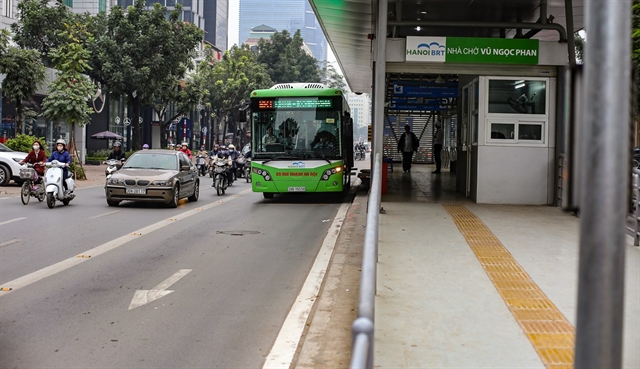
HÀ NỘI — Hà Nội’s Department of Transport has proposed the municipal People’s Committee to allow passenger cars with 24 seats or more, official vehicles, ambulances and fire trucks to use Bus Rapid Transit (BRT) lanes in the capital.
This is part of the measures that the department proposed on Thursday in a report on traffic adjustment to solve congestion on some roads.
According to the department, despite the BRT bus route being a radial axis, its operational efficiency is reduced, while the high volume of vehicles, especially during peak hours, causes congestion. Allowing other vehicles to enter the BRT lane is expected to reduce congestion and increase the efficiency of traffic infrastructure.
Hà Nội’s first rapid bus route, Kim Mã-Yên Nghĩa, started construction in early 2013, and began operations at the end of 2016. The bus route runs along Yên Nghĩa-Ba La-Lê Trọng Tấn-(extended) Lê Văn Lương-Láng Hạ-Giảng Võ-Kim Mã.
According to the calculation of the management unit, it takes about 45 minutes for the express bus to travel the 14-km long Kim Mã -Yên Nghĩa route.
The total investment in the project including the construction of infrastructure, lounges, and vehicles was US$55 million with loans from the World Bank. Việt Nam contributed reciprocal capital by the cost of site clearance.
The survey results of the Hà Nội Institute of Socio-Economics in mid-2021 show that, since starting operation, during peak hours, the BRT bus carries 40-45 passengers per trip, lessening private vehicles on the road by 400-500, contributing to reducing congestion and polluting emissions.
Because the BRT bus route component from Kim Mã to Yên Nghĩa bus station belongs to the Hà Nội urban transport development project, sponsored by the World Bank, the department proposed the city talk with the World Bank.
Intersections on the BRT route are often congested including Lê Văn Lương-Khuất Duy Tiến; Tố Hữu-Trung Văn; and Tố Hữu-Vũ Trọng Khánh.
The intersection of Lê Văn Lương-Khuất Duy Tiến is barricaded due to the construction of the Lê Văn Lương underpass, meaning the road surface area is narrowed despite the large traffic volume. Therefore, the department proposed to adjust and organise local traffic in the construction area to reduce congestion.
The intersection of Tố Hữu-Vũ Trọng Khánh is usually congested due to heavy traffic flow with many vehicles turning left from Tố Hữu to Vũ Trọng Khánh. The traffic reorganisation has been piloted since June 18, and the department will monitor and adjust accordingly.
As for the Tố Hữu-Trung Văn intersection, congestion is caused by high traffic from the Trung Văn intersection area. The department is waiting for allocated funds to expand the road surface from Trung Văn intersection to Vũ Trọng Khánh; adjusting the turning point and trimming the pavement to widen the roadway in the Bắc Hà building area.
In early 2018, the Center for Management and Operation of Urban Traffic under the city’s Department of Transport proposed normal buses use the BRT lane from 4 am to 11 pm daily. Other vehicles are allowed to use the BRT lane from 11 pm to 4 am the next day. However, the Department of Transport at that time objected, saying that the city leader affirmed that the “BRT lane is for BRT only”. — VNS
- Reduce Hair Loss with PURA D’OR Gold Label Shampoo
- Castor Oil Has Made a “Huge” Difference With Hair and Brow Growth
- Excessive hair loss in men: Signs of illness that cannot be subjective
- Dịch Vụ SEO Website ở Los Angeles, CA: đưa trang web doanh nghiệp bạn lên top Google
- Nails Salon Sierra Madre
 VnExpress News The News Gateway of Vietnam
VnExpress News The News Gateway of Vietnam





